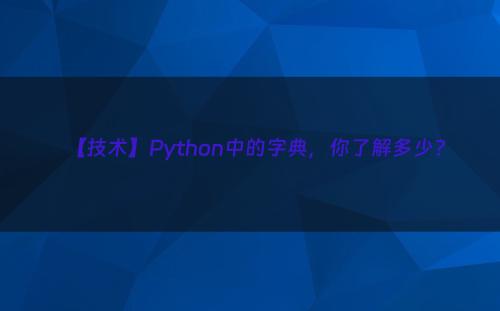1. 理解Python中的字典
1.1 什么是字典?
字典是无序的、可变的键值对集合。创建一个简单的字典
# Creating a dictionary
my_dict = {'name': 'John', 'age': 25, 'city': 'New York'}
print(my_dict){'name': 'John', 'age': 25, 'city': 'New York'}1.2 创建字典
可以使用花括号 {} 或 dict() 构造函数创建字典。以下是初始化字典的多种方式

# Using curly braces
dict1 = {'name': 'Alice', 'age': 30}
# Using dict() constructor
dict2 = dict(name='Bob', age=35)
# Creating an empty dictionary
empty_dict = {}1.3 访问和修改字典元素
访问和修改字典中的元素非常简单
# Accessing a value using a key
print(my_dict['name']) # Output: John
# Modifying a value
my_dict['age'] = 26
print(my_dict) # Output: {'name': 'John', 'age': 26, 'city': 'New York'}1.4 字典方法
字典带有各种内置方法。让我们探索一些
# Getting keys, values, and items
keys = my_dict.keys()
values = my_dict.values()
items = my_dict.items()
print(keys) # Output: dict_keys(['name', 'age', 'city'])
print(values) # Output: dict_values(['John', 26, 'New York'])
print(items) # Output: dict_items([('name', 'John'), ('age', 26), ('city', 'New York')])2. 字典操作及最佳实践
2.1 添加和删除元素
update() 和 pop() 等操作对于添加和删除元素至关重要
# Adding a new key-value pair
my_dict['occupation'] = 'Engineer'
# Removing a key-value pair
removed_value = my_dict.pop('age')
print(my_dict) # Output: {'name': 'John', 'city': 'New York', 'occupation': 'Engineer'}
print(removed_value) # Output: 262.2 迭代字典
可以使用循环来迭代字典
# Iterating through keys
for key in my_dict:
print(key, my_dict[key])
# Iterating through items
for key, value in my_dict.items():
print(key, value)2.3 字典推导式
字典推导式提供了一种创建字典的简洁方法
# Creating a dictionary using comprehension
squared_values = {num: num**2 for num in range(1, 5)}
print(squared_values) # Output: {1: 1, 2: 4, 3: 9, 4: 16}2.4 常用词典模式和习语
探索使用词典的最佳实践和常见模式。了解如何构建代码以实现清晰性和可维护性。
3. 高级词典技术
3.1 嵌套字典
字典可以嵌套来表示层次结构
# Creating a nested dictionary
employee = {
'name': 'Alice',
'position': 'Manager',
'contact': {'email': 'alice@email.com', 'phone': '123-456-7890'}
}
print(employee['contact']['email']) # Output: alice@email.com3.2 字典合并与更新
可以使用 update() 方法合并字典
# Merging dictionaries
additional_info = {'hobbies': ['reading', 'traveling']}
employee.update(additional_info)
print(employee)
# Output: {'name': 'Alice', 'position': 'Manager', 'contact': {'email': 'alice@email.com', 'phone': '123-456-7890'}, 'hobbies': ['reading', 'traveling']}3.3 处理丢失的密钥
使用 get() 方法处理丢失的键
# Using get() to handle missing key
email = employee['contact'].get('email', 'Email not available')
address = employee['contact'].get('address', 'Address not available')
print(email) # Output: alice@email.com
print(address) # Output: Address not available3.4 字典中的默认值
使用 defaultdict 设置缺失键的默认值
from collections import defaultdict
# Creating a defaultdict with a default value of 0
counter = defaultdict(int)
# Incrementing the count for each element
elements = [1, 2, 3, 1, 2, 4, 5]
for element in elements:
counter[element] += 1
print(dict(counter))
# Output: {1: 2, 2: 2, 3: 1, 4: 1, 5: 1}4. 性能优化和内存管理
4.1 内存效率
使用字典时优化内存使用至关重要
# Calculating the size of a dictionary
import sys
dict_size = sys.getsizeof(my_dict)
print(f"Dictionary Size: {dict_size} bytes")4.2 字典操作的时间复杂度
了解字典操作的时间复杂度
# Time complexity of dictionary operations
# Access, insertion, and deletion: O(1) on average
# Search: O(1) on average4.3 大字典的策略
处理大型字典的策略,包括减少内存占用和提高性能。
5. 实际应用和用例
5.1 配置管理
字典可以方便地管理配置设置
# Configuration management using dictionaries
config = {'debug': True, 'log_level': 'INFO', 'max_connections': 10}5.2 数据转换和清洗
字典促进数据转换和清理
# Data transformation using dictionaries
raw_data = {'id': 1, 'name': 'John Doe', 'age': '25'}
cleaned_data = {key: value for key, value in raw_data.items() if key != 'age'}
print(cleaned_data) # Output: {'id': 1, 'name': 'John Doe'}5.3 缓存和记忆
字典对于缓存和记忆至关重要
# Caching with dictionaries
cache = {}
def expensive_operation(n):
if n in cache:
return cache[n]
result = n * n
cache[n] = result
return result5.4 JSON序列化和反序列化
字典在 JSON 序列化和反序列化中起着关键作用
import json
# JSON serialization
json_data = json.dumps(my_dict)
# JSON deserialization
new_dict = json.loads(json_data)6. 与其他Python数据结构集成
6.1 列表与字典
列表和字典在不同场景下的使用对比
# Lists vs. dictionaries
# Use lists when order matters and indexing is crucial
# Use dictionaries for key-value pairs and fast lookups6.2 集合和字典
探索集合和字典之间的关系
# Using sets with dictionaries
unique_keys = set(my_dict.keys())
print(unique_keys)6.3 字典中的元组键
使用元组作为字典中的键
# Using tuples as keys
tuple_dict = {('Alice', 25): 'Manager', ('Bob', 30): 'Developer'}
# Accessing a value using a tuple key
position = tuple_dict[('Alice', 25)]
print(position) # Output: Manager7. 面向对象编程中的字典
7.1 在字典中存储对象属性
使用字典来存储和管理对象属性
# Storing object properties in a dictionary
class Employee:
def __init__(self, name, age, position):
self.properties = {'name': name, 'age': age, 'position': position}
# Creating an Employee object
emp = Employee('John', 28, 'Engineer')
print(emp.properties['name']) # Output: John7.2 对象的序列化和反序列化
使用字典进行对象序列化和反序列化
# Serialization and deserialization of objects
class Employee:
def __init__(self, name, age, position):
self.name = name
self.age = age
self.position = position
def to_dict(self):
return {'name': self.name, 'age': self.age, 'position': self.position}
@classmethod
def from_dict(cls, data):
return cls(data['name'], data['age'], data['position'])
# Serializing an Employee object
emp = Employee('Alice', 32, 'Manager')
emp_dict = emp.to_dict()
# Deserializing a dictionary to an Employee object
new_emp = Employee.from_dict(emp_dict)8. 常见陷阱以及如何避免它们
8.1 可变性和不变性
避免字典中可变对象引起的意外行为
# Pitfall: Mutable keys
mutable_key = [1, 2, 3]
my_dict[mutable_key] = 'Mutable Key'8.2 密钥冲突和哈希
了解按键冲突并优化字典性能
# Pitfall: Key collisions
hashed_key = hash(mutable_key)
print(hashed_key)8.3 字典操作的意外副作用
编写健壮的代码以避免常见的陷阱
# Pitfall: Unintended side effects
keys = list(my_dict.keys())
for key in keys:
if key == 'name':
del my_dict[key]9. 未来趋势和更新
9.1 Python 字典的最新变化(截至 2022 年)
探索 Python 词典的最新更改和更新
# Recent changes in Python dictionaries (as of 2022)
# (Check Python release notes for the latest updates)9.2 字典增强的 PEP 和提案
随时了解正在进行的与字典相关的 Python 增强提案 (PEP)
# PEPs and proposals for dictionary enhancements
# (Check Python PEP repository for the latest proposals)